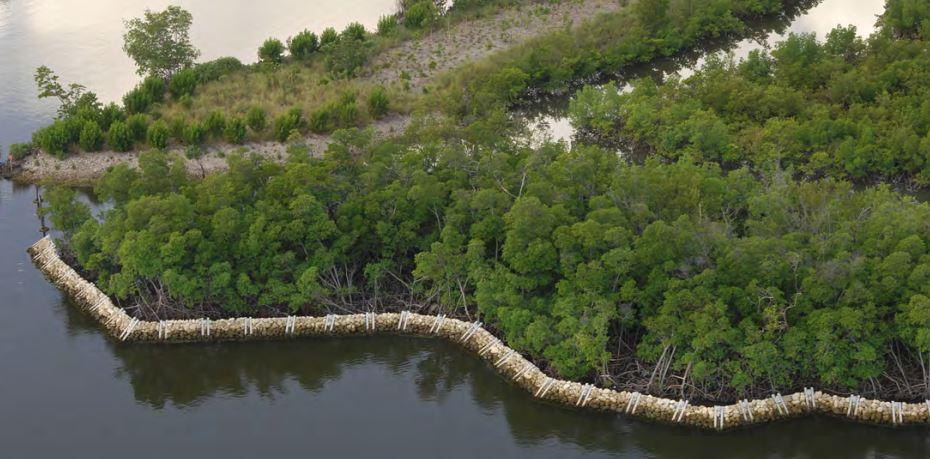Restoring Offshore Features
Restoration is the process of establishing or reestablishing a habitat that closely resembles a natural condition in terms of structure and function. Oyster reefs, coral reefs and seagrasses can help buffer storm surges and wave action, prevent erosion, improve water quality, and provide habitat for marine species. Oyster reefs protect coasts from storm surge and wave action and help reduce coastal erosion. Oyster reefs also support vegetation in marshes and seagrass beds which can mitigate coastal flooding. Coral reefs and seagrass also protect coasts from erosion. Coral reefs have been shown to reduce wave energy by 97% and wave height by 84%.
Unfortunately, naturally occurring reefs and seagrass beds have suffered extreme losses and degradation throughout the United States and the globe from the effects of pollution, sedimentation, increasing water temperatures, and direct impacts from fishing and other marine activities. Successful offshore restoration efforts have taken a number of approaches, but often include a focus on improving local water quality, providing substrate for juvenile oysters and coral to attach to, and reducing the direct impact of boat or fishing activities on the habitats themselves.
Restoration of offshore features can be used in any coastal area regardless of size. Offshore restoration can be more successful when large areas are restored because as water quality improves and wave action decreases it becomes easier to make restoration projects successful, creating a positive feedback and improving the likelihood of success for further restoration efforts.
Siting Considerations
While reefs and seagrass beds can be restored in most coastal areas, particularly where there are remnants of the original population still available, local water quality, clarity, and temperature all provide important considerations when considering where restoration efforts may be most successful. Additionally, identifying areas outside of navigational channels and protected from direct impacts of fishing activities in particular will increase the likelihood of success.
Water quality – Excess nitrogen pollution is generally considered the biggest threat to seagrass health. Identifying areas with relatively clean water and low levels of nitrogen pollution will increase the likelihood of success of restoration projects. Making investments in improving water quality has also shown to provide considerable benefits to restoration efforts. In an attempt to restore historic seagrass beds. Tampa Bay, Florida invested in improving their local water quality and has seen an expansion of more than 5000 acres of seagrass beds between 2012 and 2014.
Water clarity and sedimentation – Corals and seagrasses require relatively clear water to allow for photosynthesis to occur. Additionally, sedimentation – the collecting of sediment on the reefs themselves – can be a major issue for coral reef health. Limiting the amount of sediment and the amount of turbidity in the water column, or identifying areas with high water clarity, will increase the likelihood of successful restoration.
Water temperature – Water temperatures have been directly linked to seagrass and coral health. Overly warm waters have resulted in coral bleaching events
Proximity to commercial and recreational activities – In addition to the concerns associated with finding an appropriate location for restoration, oyster reef restoration efforts are often prohibited in close proximity to existing shellfish farming operations to reduce any potential impacts on aquaculture and discourage harvest of restored reefs.
Costs
Costs for restoration efforts vary considerably based on the primary threat that needs to be addressed. If nitrogen pollution is the limiting factor in an area, costs for addressing the threat may be substantial as it may require investments in upgraded wastewater treatment systems or addressing land based runoff into local water ways.
When considering costs of a physical restoration project itself, seagrass and oysters need to be purchased and established in the identified target area. Coral can be grown off site or existing coral reefs can be propagated onsite. There can be significant material and personnel costs with all of these strategies. However, a study comparing the cost of constructing breakwaters found them to be 15 times more expensive than restoring a coral reef, while other studies looking at the benefits of oyster reef restoration along the Gulf coast found that every mile of oyster reef would save homeowners nearly $1 million in rip rap construction costs or $1.5 million in breakwater construction costs.

Co-Benefits of the Strategy
Healthy seagrass beds, coral reefs, and oyster reefs play a vital role in providing shelter, habitat, and food for numerous species in the nearshore environment. Some estimates have found that nearly 25% of all marine species rely on coral reefs for some aspect of their life cycle. While not quite as diverse, oyster reefs and seagrass beds play similarly important roles in the nearshore environment.
In addition to providing habitat, oyster reefs and seagrass beds help to clean the water column. A single oyster is able to filter 50 gallons of water a day, cleaning it of pollutants and nutrients that reduce overall water quality. Seagrass beds are able to stabilize the sea floor and trap sediment, improving overall water clarity.
Of the species that rely on reefs and seagrass beds, many are recreationally or commercially important. According to NOAA, the commercial value of coral reef based fisheries is more than $100 M annually across the United States. In Florida, approximately 70% of commercial and recreational species rely on seagrass beds during some phase of their life. In addition to providing habitat to striped bass, menhaden, and numerous other commercial species, oyster reefs provide the foundation of the oyster fishery, which produced an annual harvest in 2014 of nearly $250 M nationwide.
In addition to their contribution to fisheries, all three offshore habitats create recreational opportunities. Coral reef based tourism in the Florida Keys has been estimated to provide more than $1 B of economic activity annually.
Maintenance Considerations
Generally speaking, once these offshore areas are established they will be mostly self-sustaining. Care needs to be taken to make sure that direct impacts from shellfish harvest or fishing are not occurring. In areas where water quality was an issue limiting restoration, regular testing and monitoring should be undertaken to ensure that pollution is not returning to toxic levels for these species.
Similar or Complementary Solutions
While Living Breakwaters rely on the benefits provided by coral and oyster reefs, that strategy focuses first on siting the breakwater to reduce wave action whereas restoration of offshore features focuses on improving the biological conditions to return these features to areas where they are most likely to succeed.
Additional Resources
NOAA has formed a Coral Reef Conservation Program that provides considerable guidance and resources for anyone interested in conservation or restoration.
The Oyster Restoration Working Group, a partnership of governmental, academic, and not-for-profit organizations, has collected an enormous wealth of resources for anyone interested in oyster restoration.
The University of Rhode Island has amassed a very good overview of seagrass restoration techniques and links to the scientific literature, as well as some links to potential sources of funding.

